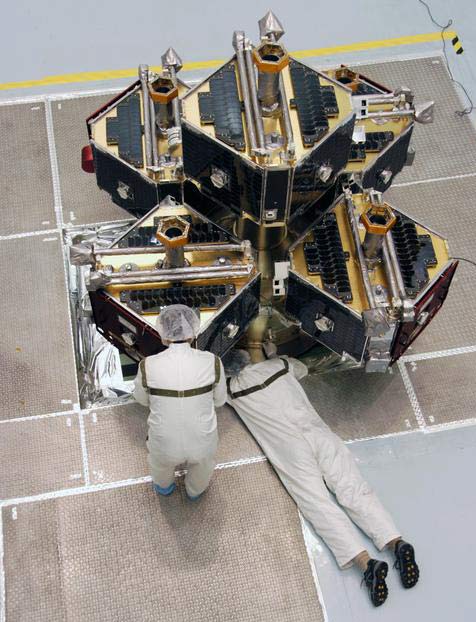NASA Primes Five Satellites for Stormy Hunt

NASA isreadying five small satellites to launch spaceward next month on a mission topinpoint the source of aurora-boosting storms from Earth's magnetic field.
Thespacecraft quintet is part of NASA's THEMIS mission to find the trigger pointof geomagnetic substorms, which begin somewhere in the Earth's magnetic fieldand, within minutes, swoop inside the Moon's orbit to the planet's upperatmosphere and brighten the aurora borealis - also known as the NorthernLights. The speed of the substorms makes tracking their starting pointimpossible with a single spacecraft, mission researchers said.
"Findingthe elusive substorm point of origin is a question almost as old as spacephysics itself," THEMIS principal investigatorVassilis Angelopoulos, of the University of California at Berkeley, toldreporters in a Wednesday teleconference. "[The mission] is a stepping stonetowards understanding space weather phenomena that affect our lives."
A UnitedLaunch Alliance Delta 2 rocket is slated to loft the THEMIS mission, which isshort for the lengthy moniker Time History of Events and MacroscaleInteractions during Substorms, on Feb. 15 during a 19-minute window that opensat 6:07 p.m. EST (2307 GMT) [image].The $200 million mission, the launch of which has been delayed since Octoberdue to booster issues, is named for the Greek goddess of justice, NASAofficials said [image].
"We lookforward to some terrific scientific discoveries," THEMIS project manager PeterHarvey, also of UC Berkeley, told reporters.
Firstidentified in the 19th century, geomagnetic substorms are recurringphenomena spawned by a sudden release of charged particles - collected from theSun's solar wind - in the Earth's magnetic field. The high-energy particlesfollow the Earth's magnetic field lines until they strike the upper atmosphere,giving a boost to the Northern Hemisphere's aurora borealis, researchers said.
While asubstorm's aurora amplification seems like a limited visual effect, a series ofsuch storms can occur during major space weather events that interfere withcommunications satellites or pose risks to astronauts in orbit, Angelopoulossaid.
Get the Space.com Newsletter
Breaking space news, the latest updates on rocket launches, skywatching events and more!
Only fourTHEMIS satellites are required to complete a primary two-year mission [image].After reaching orbit, two of the probes will be sent on a trajectory thatcarries them about one-sixth of the way to the Moon while two others take upstations about halfway to the Moon. The spacecraft will line up with oneanother and ground stations on Earth every four days during their respectiveorbits, researchers added [image].
The fifthTHEMIS satellite is a spare in case one of its counterparts fails during theinitial two-year mission.
"We'reflying five to increase our reliability," Angelopoulos said.
- VIDEO: Aurora - Dangerous Beauty
- IMAGES: Colorful Auroras
- SPACE.com Cams: Real-time Views of the Sun, Earth and Auroras
- All About Auroras
Join our Space Forums to keep talking space on the latest missions, night sky and more! And if you have a news tip, correction or comment, let us know at: community@space.com.

Tariq is the Editor-in-Chief of Space.com and joined the team in 2001, first as an intern and staff writer, and later as an editor. He covers human spaceflight, exploration and space science, as well as skywatching and entertainment. He became Space.com's Managing Editor in 2009 and Editor-in-Chief in 2019. Before joining Space.com, Tariq was a staff reporter for The Los Angeles Times covering education and city beats in La Habra, Fullerton and Huntington Beach. In October 2022, Tariq received the Harry Kolcum Award for excellence in space reporting from the National Space Club Florida Committee. He is also an Eagle Scout (yes, he has the Space Exploration merit badge) and went to Space Camp four times as a kid and a fifth time as an adult. He has journalism degrees from the University of Southern California and New York University. You can find Tariq at Space.com and as the co-host to the This Week In Space podcast with space historian Rod Pyle on the TWiT network. To see his latest project, you can follow Tariq on Twitter @tariqjmalik.









